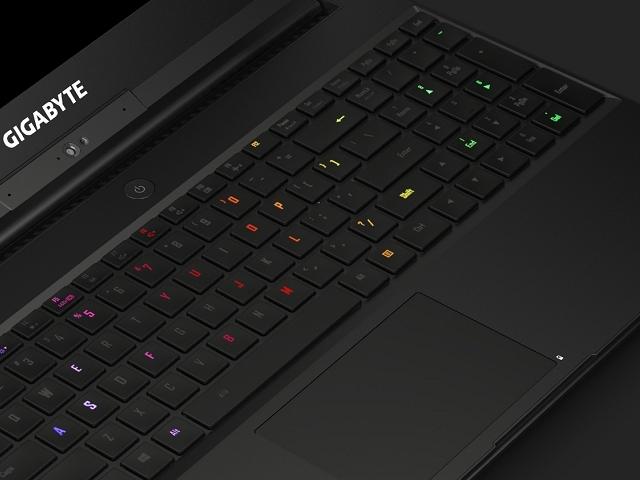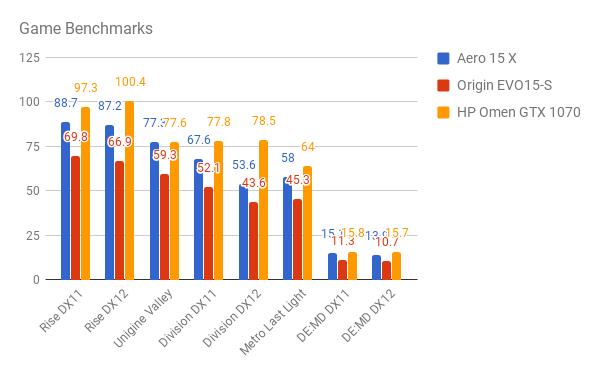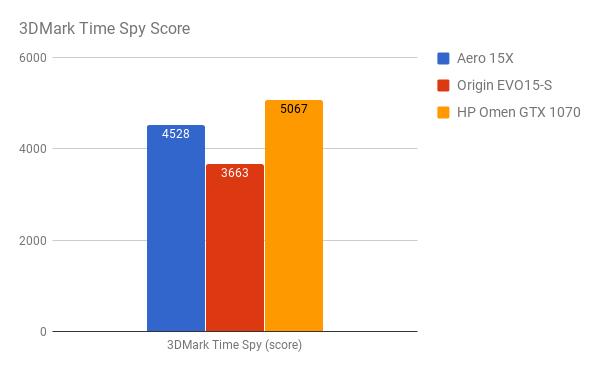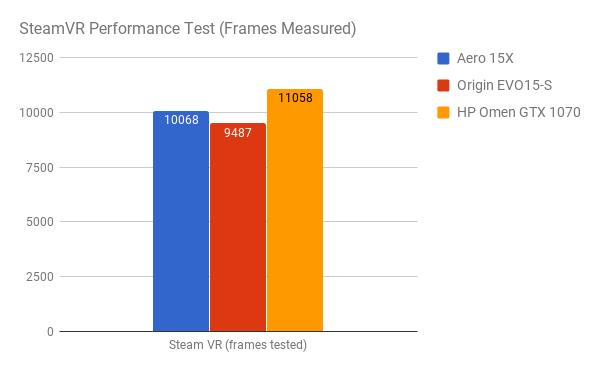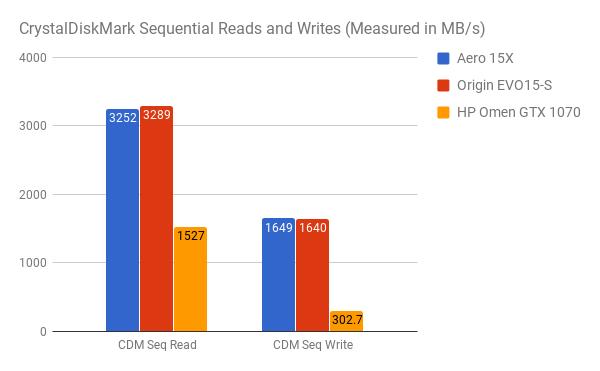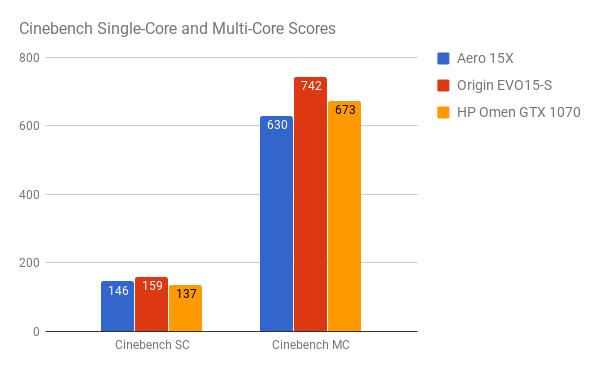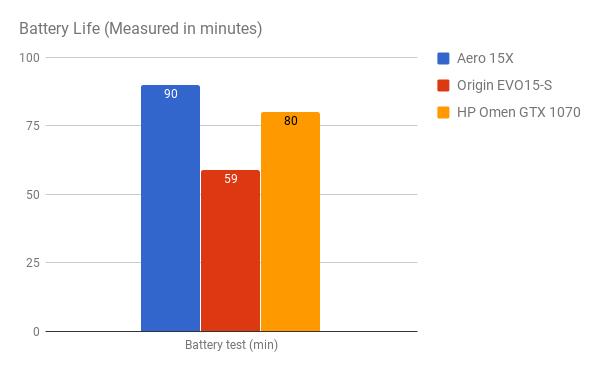Gigabyte Aero 15 X Review
GameSpot may receive revenue from affiliate and advertising partnerships for sharing this content and from purchases through links.
Aero 15 X Review
Up until recently, to squeeze something like a GPU as powerful as the GeForce GTX 1070 into a gaming laptop meant the notebook had to be big and bulky. The mid-range GTX 1060 was the most powerful card you could get into a thin and light form factor. With Nvidia’s new Max-Q line of GPUs, that’s beginning to change. Gigabyte’s Aero 15 X is a slim gaming laptop that manages to squeeze in Nvidia’s venerable GTX 1070. While there are some performance compromises due to the compact form factor, it is still powerful enough to max out most modern graphically demanding games.
Table of Contents
- Specs
- Game Benchmarks
- 3DMark Time Spy Benchmark
- VR Benchmark
- SSD Benchmark
- CPU Benchmarks
- Battery Test
- Thermals
- Conclusion
Design
The Aero 15 X uses the same chassis as Gigabyte’s Aero 15 before it. The biggest difference is that it swaps out the GTX 1060 in favor of the aforementioned GTX 1070. This means it uses a premium all-machined aluminum body. It doesn’t flex or creak undesirably like some cheaper laptops on the market. It also has very thin 5mm bezels around its display, which minimizes the notebook’s size. Its overall dimensions measure 14x9.8x.78 inches (356x250x19.9 mm). Coupled with its reasonable 4.6-pound (2.1 kilogram) weight, it’s a very portable gaming laptop.
Its monitor is good, but not great. The Aero 15 X uses a 1080p TN display. TN panels typically don’t offer the same color accuracy or wide viewing angles as more expensive IPS variants, but the viewing angles are surprisingly great here. Since the Aero 15 X is equipped with the GTX 1070, which is a great GPU for 1440p, we would have appreciated a higher resolution panel or at least one with a faster refresh rate than 60Hz. There’s also no G-Sync support, so you don’t get a variable refresh rate display.
We also had a minor gripe with the keyboard. While we like the fact that it features all programmable keys and looks great with its 16.7 million per-key customizable colors, the keys require a little more actuation force for typing than we like. The Elan touchpad works well and supports multi-touch gestures such as two-finger scrolling, zooming, and more, but we do wish it had dedicated left and right click buttons to prevent accidental clicks.
Despite the laptop’s compact size, it offers a good assortment of ports. On the left, it features ports for Ethernet, USB 3.0, HDMI 2.0, combo audio jack, and Mini DisplayPort. To the right, it has two USB 3.0 ports, an SD card reader, and a USB-C port, which supports Intel’s speedy Thunderbolt 3 connection that allows transfer speeds up to 40Gbps.
Specs
CPU | Intel Core i7-7700HQ |
GPU | Nvidia GeForce GTX 1070 (8GB) |
RAM | 16GB 2400MHz Dual Channel DDR4 Memory |
Display | 15.6-inch 1920x1080 TN |
Storage | 512GB M.2 NVMe |
Ports | 1x Thunderbolt 3 (Type-C), 3xUSB 3.0, 1xHDMI, 1xMini DisplayPort, combo audio jack, Ethernet, SD card reader |
The Aero 15 X is equipped with Intel’s 4-core/8-thread i7-7700HQ CPU clocked at 2.8GHz. It’s paired with 16GB of RAM clocked at 2400MHz configured in a dual-channel setup. Those are great specs, but the real star of the show is the Max-Q GTX 1070.
Nvidia borrowed the term Max-Q from NASA, and its used to refer to mobile GPUs that are tuned with a balance of performance and power consumption in mind. On the downside, this means it’s slightly lower clocked than its non Max-Q counterparts, but the upside is that it’s able to fit into svelte gaming laptop chassis. Nvidia asserts that Max-Q GPUs are still able to harness most of the performance of their traditional models for a smaller fraction of the power consumption.
In terms of storage, our Aero 15 X is outfitted with Samsung’s high-end 512GB SM961 NVMe solid-state drive. While the speedy SSD is appreciated, 512GB is really the minimum amount of space we’d recommend in a gaming system. Luckily, the laptop does support an additional M.2 slot, so you can outfit it with more storage.
Game Benchmarks
To give you some points of comparison for performance, we’re going to benchmark the Aero 15 X against the bigger HP Omen, which features a non Max-Q GTX 1070 and the more portable Origin PC Evo15-S, which is equipped with a standard GTX 1060.
For our game benchmarks, we ran all titles at their respective max settings at 1080p to really stress test the GPUs.
As you can see from our gaming benchmarks above, the Aero 15 X performs in between the HP Omen and the Origin Evo 15-S. Luckily, it’s definitively faster than the Evo 15-S with its GTX 1060 and often gets close with the HP Omen and its more power-hungry GTX 1070 variant.
With the exception of Deus Ex: Mankind Divided, which is arguably the most graphically demanding game in existence, the Aero 15 X produced silky smooth frame rates across the board. Our results do show that the Max-Q GPU makes some slight performance compromises against the Omen and its standard GTX 1070, however. If you’re looking for uncompromising performance, you may be slightly disappointed here, but it’s important to keep in mind that HP’s laptop is much bigger and heavier than the Aero 15 X.
3DMark Time Spy Benchmark
3DMark Time Spy is a synthetic benchmark that measures DirectX 12 performance and provides a score. According to our test, the Aero 15 X performed 11 percent worse than the HP Omen, but was 24 percent better than Evo 15-S.
VR Benchmark
In Valve’s SteamVR Performance Test, the Aero 15 X scored a “very high” mark and performed six percent better than the Evo 15-S. This makes it a great laptop for VR gaming, though it did score nine percent worse than the HP Omen.
SSD Benchmark
All three gaming laptops have fast solid-state drives, particularly the Aero 15 X and Evo 15-S, which both use speedy NVMe SSDs. According to CrystalDiskMark, Gigabyte’s laptop scored respective sequential read and write speeds of 3,252 and 1,649 MB/s. Considering most traditional SATA-based SSDs top out with sequential read and write speeds of 550 and 490 MB/s, respectively, that’s wicked fast.
CPU Benchmarks
For our CPU benchmark, we used Cinebench, which offers tests for both single-core and mult-core performance. This is the only test in which the Origin Evo 15-S is able to lead the pack. The Aero 15 X and the HP Omen performed roughly on par, which is slightly disappointing for the Gigabyte notebook considering it uses a newer Kaby Lake i7 SKU vs HP’s older Skylake equivalent.
Battery Test
For our battery test, we looped the Unigine Valley benchmark until the laptop keeled over. Considering the graphics test is pretty strenuous, it should represent a worst-case gaming scenario. The Aero 15 X and its 94Whr battery lasted 90 minutes here. This is actually really impressive when you consider the fact that the Omen lasted 80 minutes and the Evo 15-S just 59. The extra battery life is most likely due to the power savings from Nvidia’s Max-Q technology, which keeps power-hungry GPUs at bay.
Thermals
When we ran the Unigine Valley benchmark and monitored CPU temperatures on the Aero 15 X, it’s idle temperature rose from the high 40 degrees C to the high 70 degrees C. Here, the GPU rose from the low 40 Cs to the high 60s. These are very reasonable temperatures for a gaming laptop, and the Aero 15 X does a great job pushing heat through the back and never felt uncomfortably warm, which is a noticeable feat for a laptop this svelte. Despite the more efficient Max-Q GPU, though, the laptop’s fans still got loud when we gamed with it.
Conclusion
Gigabyte’s $2,199 Aero 15 X is a fast gaming laptop, but it isn’t the fastest. Its Max-Q GTX 1070 is slightly slower than standard variants, but performance shouldn’t be the only aspect you should look for in a gaming notebook. With its more power-consciousness GPU, Gigabyte is able to deliver a thin and light gaming notebook that offers good battery life and still packs a performance punch.

